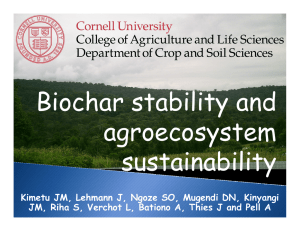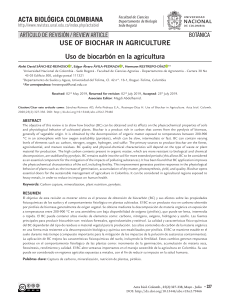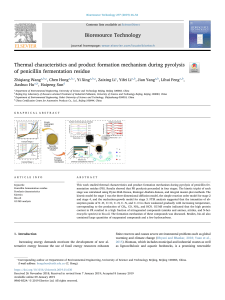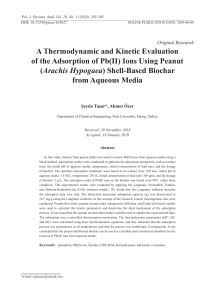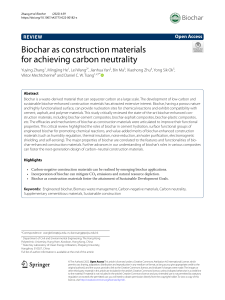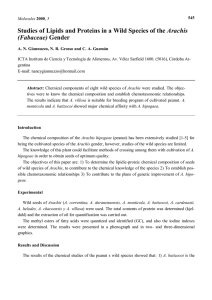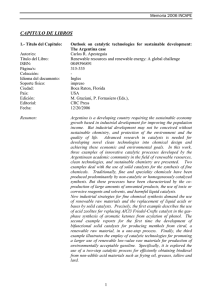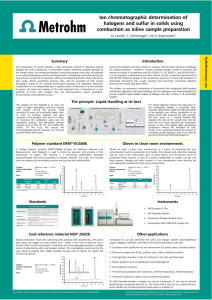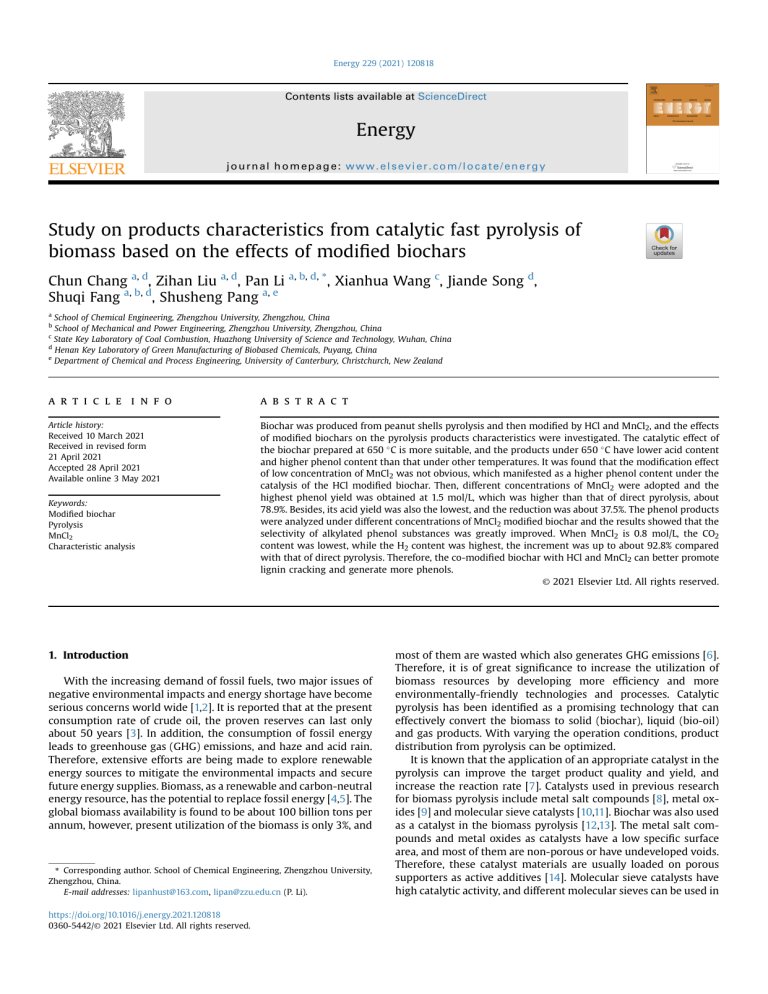
Energy 229 (2021) 120818 Contents lists available at ScienceDirect Energy journal homepage: www.elsevier.com/locate/energy Study on products characteristics from catalytic fast pyrolysis of biomass based on the effects of modified biochars Chun Chang a, d, Zihan Liu a, d, Pan Li a, b, d, *, Xianhua Wang c, Jiande Song d, Shuqi Fang a, b, d, Shusheng Pang a, e a School of Chemical Engineering, Zhengzhou University, Zhengzhou, China School of Mechanical and Power Engineering, Zhengzhou University, Zhengzhou, China State Key Laboratory of Coal Combustion, Huazhong University of Science and Technology, Wuhan, China d Henan Key Laboratory of Green Manufacturing of Biobased Chemicals, Puyang, China e Department of Chemical and Process Engineering, University of Canterbury, Christchurch, New Zealand b c a r t i c l e i n f o a b s t r a c t Article history: Received 10 March 2021 Received in revised form 21 April 2021 Accepted 28 April 2021 Available online 3 May 2021 Biochar was produced from peanut shells pyrolysis and then modified by HCl and MnCl2, and the effects of modified biochars on the pyrolysis products characteristics were investigated. The catalytic effect of the biochar prepared at 650 C is more suitable, and the products under 650 C have lower acid content and higher phenol content than that under other temperatures. It was found that the modification effect of low concentration of MnCl2 was not obvious, which manifested as a higher phenol content under the catalysis of the HCl modified biochar. Then, different concentrations of MnCl2 were adopted and the highest phenol yield was obtained at 1.5 mol/L, which was higher than that of direct pyrolysis, about 78.9%. Besides, its acid yield was also the lowest, and the reduction was about 37.5%. The phenol products were analyzed under different concentrations of MnCl2 modified biochar and the results showed that the selectivity of alkylated phenol substances was greatly improved. When MnCl2 is 0.8 mol/L, the CO2 content was lowest, while the H2 content was highest, the increment was up to about 92.8% compared with that of direct pyrolysis. Therefore, the co-modified biochar with HCl and MnCl2 can better promote lignin cracking and generate more phenols. © 2021 Elsevier Ltd. All rights reserved. Keywords: Modified biochar Pyrolysis MnCl2 Characteristic analysis 1. Introduction With the increasing demand of fossil fuels, two major issues of negative environmental impacts and energy shortage have become serious concerns world wide [1,2]. It is reported that at the present consumption rate of crude oil, the proven reserves can last only about 50 years [3]. In addition, the consumption of fossil energy leads to greenhouse gas (GHG) emissions, and haze and acid rain. Therefore, extensive efforts are being made to explore renewable energy sources to mitigate the environmental impacts and secure future energy supplies. Biomass, as a renewable and carbon-neutral energy resource, has the potential to replace fossil energy [4,5]. The global biomass availability is found to be about 100 billion tons per annum, however, present utilization of the biomass is only 3%, and * Corresponding author. School of Chemical Engineering, Zhengzhou University, Zhengzhou, China. E-mail addresses: lipanhust@163.com, lipan@zzu.edu.cn (P. Li). https://doi.org/10.1016/j.energy.2021.120818 0360-5442/© 2021 Elsevier Ltd. All rights reserved. most of them are wasted which also generates GHG emissions [6]. Therefore, it is of great significance to increase the utilization of biomass resources by developing more efficiency and more environmentally-friendly technologies and processes. Catalytic pyrolysis has been identified as a promising technology that can effectively convert the biomass to solid (biochar), liquid (bio-oil) and gas products. With varying the operation conditions, product distribution from pyrolysis can be optimized. It is known that the application of an appropriate catalyst in the pyrolysis can improve the target product quality and yield, and increase the reaction rate [7]. Catalysts used in previous research for biomass pyrolysis include metal salt compounds [8], metal oxides [9] and molecular sieve catalysts [10,11]. Biochar was also used as a catalyst in the biomass pyrolysis [12,13]. The metal salt compounds and metal oxides as catalysts have a low specific surface area, and most of them are non-porous or have undeveloped voids. Therefore, these catalyst materials are usually loaded on porous supporters as active additives [14]. Molecular sieve catalysts have high catalytic activity, and different molecular sieves can be used in C. Chang, Z. Liu, P. Li et al. Energy 229 (2021) 120818 periodic table. It is not only abundant in the earth's crust but also an indispensable trace element for plant growth and hence it is cost effective to purchase. Meanwhile, it is speculated that peanut shells may contain a high content of manganese due to peanuts are one of the food sources of manganese. Therefore, it is necessary to explore the effect of manganese on the pyrolysis of peanut shells. Moreover, in some researches it has been confirmed that manganese can catalyze reactions such as dehydrogenation, hydrogenation, and deoxygenation [29,30], which are beneficial to the upgrading of bio-oil. In addition, the use of peanut shell as the raw material and the catalyst precursor was executed to generate higher yields of bio-oil products by pyrolysis. The influence of MnCl2 and HCl on biochar and the influence of biochar and its modification on the pyrolysis process of peanut shell were discussed in details through analyzing the changes of product components, and meanwhile the methods of the preparation of biochar catalyst were optimized through the results of the pyrolysis process of peanut shell. different reaction environments. However, in the process of biomass pyrolysis, coke deposition on molecular sieves catalyst is the main reason of catalyst deactivation [15e18]. Biochar is derived from the pyrolysis of biomass and is generally used as a fuel to supply energy [19]. Studies have shown that biochar has abundant surface functional groups, a large specific surface area, and an excellent void structure [20], which indicates that biochar can be used as a catalyst for bio-oil upgrading following the pyrolysis process. In recent years, researchers have been conducted on the catalytic effect of biochar on biomass pyrolysis. Yang et al. [21] studied the catalytic effect of bamboo biochar on biomass pyrolysis, and found that the biochar, with larger specific surface area and oxygen-containing functional groups, showed catalytic effect to promote conversion of pyrolysis intermediates to phenols, however, the catalytic effect of the biochar largely depends on the oxygen-containing functional groups. During the pyrolysis, the oxygen-containing functional groups will be consumed in the catalytic process, which is not conducive to recycling. To improve the catalytic effect of biochar, biochar treatments have been reported, which include alkali modification, acid modification, metal oxide modification and metal salt modification. The introduction of nitrogen atoms into biochar can increase the electronic effect and alkalinity of biochar, and thus enhance the adsorption capacity of CO2 [22,23]. The studies of Chen et al. [24] have found that nitrogen doping in biochar is beneficial to the adsorption of acid gases or volatiles, however, the form of N in nitrogen-doped biochar is uncertain, therefore, controlling the content of various nitrogencontaining functional groups is impossible. Chellappan and Nair [25] found that the hydrophobicity of biochar increases with increasing the pyrolysis temperature, and the introduction of sulfonic acid groups can promote esterification and transesterification, but its preparation may cause more pollution. Huo et al. [1] used phosphoric acid and MgO to activate biochar, which improved the yield of bio-oil and the selectivity of alkylated phenol, however, biochar production through microwave pyrolysis is difficult to scale up, and the stability of microwave-prepared biochar in a tube furnace needs to be considered. From previous studies, it is found that the catalytic effect of biochar and its modified form can be applied in the biomass pyrolysis to promote the yield of phenols and to inhibit the generation of acids [1,21,24,26]. However, the composition of liquid product components varies significantly due to different raw materials to produce the biochar and the biochar modification method. The objective of this study is to investigate the catalytic effects of biochar from catalytic fast pyrolysis of peanut shells. Peanut shell (PS) is one of the residue of the peanut industry. China is the first leading producer of peanuts in Asia. The resource of peanut shells in China is about 5 million tons per annum, but its utilization is limited to animal food and combustion fuel and even most of them are abandoned. In addition, Peanut shell may be transformed into bioenergy products in an environmentally friendly way due to its lower content of nitrogen and sulfur which just causes a small amount of acid gas to be released during pyrolysis and combustion [27]. According to Varma reports [28], the activation energy of peanut shells is lower than that of most biomass raw materials, so it has great potential for pyrolysis to produce bio-energy products. Therefore, peanut shell was selected as feedstock of pyrolysis process as a lignocellulosic biomass. In this study, MnCl2 supported on peanut shell biochar or peanut shell biochar treated with HCl, were prepared in two step through first carbonizing peanut shell and secondly impregnating biochar with HCl/MnCl2. Then the prepared biochar and its modification were used for catalyst during the pyrolysis process of peanut shell. Manganese is a transition metal which is adjacent to iron in the 2. Materials and methods 2.1. Experimental materials Dry peanut shells were collected from local farms near Zhengzhou City, Henan Province, China, and used as feedstock materials for pyrolysis. After received, the peanuts shells were oven dried and ground to particles with particle sizes in the range of 0.25e0.425 mm screened with 40 and 60 meshes. Proximate analysis (according to the GB/T 28,731-2012 standards) and ultimate analysis (using the Vario EL III element analyzer) were then performed and the results are given in Table 1. From Table 1, it is observed that the fixed carbon content of the peanut shells is 21.29% which is higher than wood biomass, indicating that there is a high biochar yield during the preparation of biochar catalyst. Meanwhile, the low ash content (2.40%) means that pickling pretreatment of the raw materials is not necessary, because pickling cannot remove more ash based on 2.4% ash content. In addition, the volatile, hydrogen and oxygen contents of peanut shells are 68.07%,5.83% and 49.59%, respectively, which are positively related to the formation of liquid and gaseous of organic compounds. Moreover, 0.23% sulfur and 1.04% nitrogen contents indicate it may cause little acid gas to be released during pyrolysis. 2.2. Preparation and modification of peanut shell biochar In preparation of the biochar, a certain mass, 20 g, of peanut shell particles was first weighed, and then put into the tube furnace reactor as shown in Fig. 1. After purging with nitrogen gas (purity of 99.9%), the reactor was heated up through tube furnace at 5 C/min to 550 C, 650 C and 750 C, respectively, and was maintained at the target temperature for 1 h. During the heating up and the operation, the nitrogen gas was injected to the reactor top as carrier gas at a flow rate of 200 mL/min. After the experiment, the reactor was cooled down to room temperature and the solid product, biochar, was collected for analysis and modification. The biochar was modified in three ways: (1). HCl modification (HC), (2). MnCl2 modification at moderate concentration of 0.2 mol/L (MC); (3). Table 1 Proximate analysis and ultimate analysis of peanut shells. Feedstock Peanut shells a 2 Proximate analysis/% ultimate analysis/% M A V FCa N C H S Oa 8.24 2.40 68.07 21.29 1.04 43.31 5.83 0.23 49.59 Estimated by difference. C. Chang, Z. Liu, P. Li et al. Energy 229 (2021) 120818 then out of the reactor from the bottom. Before the experiment, 4 g of biochar or modified biochar obtained from section 2.2 was first placed on the bed in bottom of the furnace reactor, and the reactor was purged using N2 gas. Then the reactor was heated up at heating rate of 22 C/min to the target temperature of 550 C. Once this temperature was reached, the peanut shell particles were continuously added to the reactor from the top of the tube furnace, and N2 gas was also injected to the reactor top as carrier gas at flowrate of 200 mL/min. The gas and vapors produced in the pyrolysis flew with N2 downwards, first passed through the biochar catalysis bed at the reactor bottom, and then flew through the condenser at temperature from 10e13 C. The condensed liquid was collected in the conical flask, and the non-condensed gas was subsequently dried and filtered, and finally sampled in an airbag. After the experiment, the quartz tube reactor was cooled down to room temperature. Then the bio-oil and the biochar products from the pyrolysis as well as the biochar catalyst were collected, respectively, and weighed using an analytical balance to determine the product yields. Fig. 1. Biomass catalytic pyrolysis reaction system. 1-Nitrogen cylinder, 2-Mass flow meter, 3-Feeder, 4-Quartz tube, 5-Raw material, 6-Tube furnace, 7-Catalyst, 8Condenser, 9-Conical flask, 10-Scrubber (containing silica gel and absorbent cotton), 11-Air bag, 12-Cold trap. 2.4. Instrumental analysis BK100-01 automatic surface area and pore analyzer based on N2 adsorption and desorption isotherm, manufactured by Beijing Jingwei Gaobo Science and Technology Co., Ltd., was used to determine the pore structure parameters of biochar and the modified biochar. Before the analysis, the biochar sample was degassed in vacuum at 300 C for 5 h, using N2 as the adsorption gas, and its specific surface area was calculated according to the Brunauer-Emmett-Teller (BET) formula [31]. The result is the average of three measurements. Fourier Transform Infrared Spectrometer (FT-IR), using KBr compressed tablets to prepare samples, was used to analyze the biochar and modified biochar in spectral analysis range of 400 cm1e4000 cm1 with resolution of 1 cm1. X-ray diffraction (XRD) of model X0 Pert PRO X-ray diffractometer of PANalytical, Netherlands, was used to analyze the crystalline phase characteristics of the biochar and modified biochar. Parameter settings for the analysis were 40 kV voltage, 40 mA current, Cu as anode target with scan step of 0.0167 and scan speed of 5 /min in the scan range of 10 ~80 . Gas chromatograph (GC-14C, Shimadzu Corporation) was used to analyze the gas products. Standard gas control procedure was firstly used to identify the gas species and the external standards were used to quantitatively analyze the main components of gas products (CO, CO2, H2, CH4). The instrument conditions for the measurement: Column is of Shimadzu TDX-01 (2 m 3 mm), carrier gas is Ar, carrier(M) pressure is 0.1 MPa, injection volume is 100 mL, injection port temperature is 100 C, column box temperature is 80 C, detector temperature is 150 C. The result is the average of three measurements. Gas Chromatography/Mass Spectrometer (GC-8860/MS-5977A, Agilent Technologies Co., Ltd.) was used to analyze liquid product components. The instrument conditions for the measurement: 1) GC conditions: Column is of HP-5-MS (30 m 0.25 mm 0.25 mm), carrier gas is He, gas flow rate is 1.0 mL/min, split ratio is 50:1, injection volume is 0.2 mL, injection port temperature is 275 C, column heating program is that 40 C for 0.5 min, then raise the temperature to 270 C at a heating rate of 5 C/min and keep it for 5 min; 2) MS conditions: MS interface temperature is 280 C, scanning range is from 30 to 500 (m/Z), solvent delay time is 2 min. Shake the liquid product before dilution and shake the solution Further modification of the biochar obtained in (1) with MnCl2 at concentration of 0.2, 0.8 and 1.5 mol/L, respectively (HMC). The modification (3) was to investigate the effect of combination of HCl and MnCl2, and the loading of biochar in MnCl2 solution. In preparation of HC, the biochar obtained above was mixed with 1 mol/L HCl according to a solid-liquid mass ratio of 1:20 in a mixer which was stirred with a magnetic stirrer at 600 r/min for 6 h. Then the solution was filtered and washed with deionized water to near neutral. The solid was then oven-dried under vacuum at 105 C for 24 h. In preparation of MC, the biochar obtained above was mixed with MnCl2 at concentration of 0.2 mol/L according to the solidliquid mass ratio of 1:20 in a mixer which was stirred at 600 r/ min for 6 h. Then the solution was filtered and washed with the same amount of deionized water 3 times. The solid was then ovendried under vacuum at 105 C for 24 h. After this the modified biochar was heated to 550 C at 22 C/min under N2 (99.9%, 200 mL/ min) atmosphere, and calcined for 1 h. In preparation of HMC, the HC modified biochar was mixed with MnCl2 at concentration of 0.2 mol/L, 0.8 mol/L and 1.5 mol/L, respectively, according to the solid-liquid ratio of 1:20. The solution was stirred with a magnetic stirrer at 600 r/min for 6 h, filtered and washed with the same amount of deionized water 3 times. The solid was then oven-dried under vacuum at 105 C for 24 h. After this the over-dry solid was heated to 550 C at 22 C/min under N2 (99.9%, 200 mL/min) atmosphere, and calcined for 1 h. The biochar modified using this method was named as 0.2HMC (with concentration of 0.2 mol/L MnCl2), 0.8HMC (concentration of 0.8 mol/L MnCl2) and 1.5HMC (concentration of 1.5 mol/L MnCl2), respectively. 2.3. Catalytic pyrolysis experiment Catalytic pyrolysis experiments were conducted using the same apparatus as shown in Fig. 1 in which the carrier gas, N2, and the biomass were introduced from the reactor top and the gas and vapor product flew downwards through a catalytic biochar bed and 3 C. Chang, Z. Liu, P. Li et al. Energy 229 (2021) 120818 before testing to ensure the homogeneity of the solution. concentrations, which will make biochar form more microporous structures, instead biochar will form more mesoporous structures at high concentrations. It may make different effects on the characteristics of peanut shell pyrolysis products. 3. Results and discussion 3.1. Characterization of biochar and modified biochar as catalysts 3.1.2. FT-IR Fig. 2 shows the Fourier transform infrared (FT-IR) spectra of treated and untreated biochars from which similar patterns are observed for all of the biochars. It is found from the figure that the peak intensity of the untreated biochar prepared at 650 C at 3438 cm1 is higher than that of the biochars prepared at 550 C and 750 C, which may promote the interaction between biochar and phenolic intermediates [21,37]. The peak intensity of aliphatic CH2 (2924 and 2852 cm1) decreases continuously with the increase of temperature, indicating that organic aliphatic hydrocarbons continue to decompose at high temperatures. As can be appreciated, 650C is different from 550C to 750C in that it has more oxygen-containing functional groups, where the three peaks at 1631, 1123, and 585 cm1 are attributed to the tensile vibrations of C]O, CeO and eOH out-of-plane bending vibrations, respectively, and its peak of C]C (1400 cm1) is the weakest among the three temperatures. The results show that 650C will promote the production of phenols more than 550C and 750C [24]. After the hydrochloric acid modification (HC), the peaks of eOH moved from 3438 cm1 to 3161 cm1, from 585 cm1 to 534 cm1, respectively, and they were strengthened. Meanwhile, the peaks of C]C and CeO were strengthened, which is connected to hydrochloric acid washed away the ash content of biochar. In addition, a new peak appeared at 871 cm1, which means aromatic eCH. After MnCl2 modification (MC), the changes of various functional groups on biochar are almost the same as those of HCl modification, especially the C]C peak, which is greatly enhanced, and further promotes the conversion of C]O to CeO. After combined modification of the biochar with 0.2 mol/L MnCl2 on the basis of hydrochloric acid modification (0.2 HMC), the strength of functional groups of biochar is almost unchanged, except that the strength of C]O and CeO decreases, on the other hand, these functional groups increase with the increase of MnCl2 concentration. What's more, it can be seen from the figure that calcining weakens the peaks of eOH and CeO. Comparing the Fourier transform infrared spectra before and after the catalysis of various biochar, it is found that the peaks of eOH, CeO and C]C on the biochar after catalysis are enhanced, which indicates that some small molecules are transferred to biochar through polymerization reaction during the catalytic pyrolysis of biomass. 3.1.1. BET Table 2 shows the pore structure parameters of biochar and the modified biochar. It can be seen from the table that the original biochar has a large specific surface area of 154.710 m2/g and an average pore diameter of 2.949 nm. Based on these results, these biochar and modified biochar fall in the category of mesoporous catalysts but close to the category of microporous catalysts. It is obvious that the specific surface area of the biochar decreases significantly with increasing the preparation temperature which can be explained by the void structure collapse of the biochar at high temperatures [32]. No consistent trends are found on the effect of preparation temperature on the pore diameter and pore volume, which is due to the etching effect of high temperature has two sides. On the one hand, the high temperature causes the porous structure of biochar, that is, the pore-forming effect, and on the other hand, it causes the micropores are enlarged into mesopores or macropores, that is, the voids collapse [33]. As the temperature rises, the pore-forming effect is still dominant from 550 C to 650 C, but void collapse happening to part of micropores is inevitable, and when it reaches 750 C, the void collapse is enhanced beyond the pore-forming effect, which indicates excessive etching effects lead to the micropores are enlarged into mesopores or macropores at higher temperature. After washing of the biochar with hydrochloric acid (HC biochar), Hþ exchanges with metal ions in the biochar to form metal chloride, part of which is lost in the modified solution, and part of which stays in the voids, forming a rough surface, thereby forming a new mesoporous structure, which increases the specific surface area of the biochar [34,35]. The average pore diameter of the HC biochar is reduced slightly but the pore volume is significantly increased. When the biochar is treated with MnCl2 of 0.2 mol/L and then calcined (MC), its specific surface area is significantly increased, but the average pore diameter is closer to the biochar treated by HCl and less than that of the untreated biochar. Based on the pore diameters, the HC and MC biochars are close to the category of micropores catalysts [36]. However, with the combined treatment of biochar with MnCl2 of 0.2 mol/L (0.2 HMC), the specific surface area and average pore volume are increased and the pore diameter is decreased in comparison with those of HC and MC biochars. It is increasing to note that with increasing the concentration of MnCl2 solution, the specific surface area and the average pore volume of the biochars are decreased and the pore diameter is increased. The above phenomenon shows that the influence of hydrochloric acid modification is greater than that of MnCl2 modification at low MnCl2 3.1.3. XRD In order to compare the contents of carbon and MnCl2 in biochar and the modified biochar, XRD analysis was performed. The results of the biochar and three modified biochars, namely, biochar prepared at 650 C (650C), and modified biochars of HC, MC and 0.2HMC, are shown in Fig. 3(a) while those of the biochars of 0.8HMC and 1.5HMC are shown in Fig. 3(b). The characteristic peaks of 2q were located near 22.5 and 43.5 correspond to (001) crystal planes of disordered and amorphous carbon and (200) crystal planes of graphitized carbon [38,39], respectively. As can be appreciated, modification enhances disordered and amorphous carbon peak. In 650C and HC, a 2q peak of 28.2 was detected, which corresponds to the presence of silicon oxide [40,41]. The peak here is enhanced after washing with hydrochloric acid because the acid washing removes the ash in the biochar, exposing the graphitized carbon and silicon oxide covered by the ash, which was confirmed by the increase in the graphitized carbon peak and the increase in specific surface area in the XRD pattern after pickling, while it almost disappeared in MC and 0.2HMC because of the Table 2 Pore structure parameters of biochar. Catalyst preparation condition SBET/(m [2]/g) Average pore diameter/nm Average pore volume/(cm [3]/g) 550C 650C 750C HC MC 0.2HMC 0.8HMC 1.5HMC 245.577 154.710 99.959 271.900 400.388 414.233 362.878 352.774 3.141 2.949 3.415 2.318 2.761 1.888 3.292 3.247 0.031 0.047 0.021 0.080 0.093 0.147 0.051 0.048 4 C. Chang, Z. Liu, P. Li et al. Energy 229 (2021) 120818 Fig. 3. X-ray diffraction of biochar catalyst. corresponding to the (311) crystal planes of MnO and the (224) crystal plane of Mn3O4 [42,43], respectively. It is confirmed in the different selectivity of MC and 0.2HMC to phenols in the catalytic pyrolysis experiment. What's more, it can be seen from Fig. 3(b) that as the concentration of MnCl2 increases, there is still no peak other than the C peak in the XRD pattern of HMC, indicating that MnCl2 is highly dispersed in biochar and the particles are smaller, which is due to the fact that the hydrochloric acid washing is beneficial to the dispersion of metal active sites [26]. Fig. 2. FTIR spectra of biochar catalyst (A means after catalysis pyrolysis, B means before biochar calcination.). 3.2. Effect of temperature in the biochar preparation on its characteristics dual effects of MnCl2 and high-temperature calcination to bury elemental silicon. After biochar modification with 0.2 mol/L MnCl2, no characteristic diffraction peak of MnCl2 was observed, which indicates that MnCl2 is highly dispersed in biochar. However, new peaks (2q ¼ 35.5 , 59.2 ) appeared in the XRD pattern of MC, One of the important operating parameters for biomass pyrolysis is the reactor temperature which has significant impact on the product yields and the characteristics of each product, particularly the biochar. From previous studies, it was found that in pyrolysis of the peanut shell, high bio-oil yield can be achieved at pyrolysis temperature of 500 C [44], and the maximum conversion at 580 C 5 C. Chang, Z. Liu, P. Li et al. Energy 229 (2021) 120818 [45]. Therefore, in order to achieve the high yield of bio-oil and the high conversion in pyrolysis of the peanut shells, 550 C was chosen as the operation temperature in the experiments of the present study for the biomass pyrolysis. However, the main objective of the present study was to investigate the effect of temperature in biochar preparation on its characteristics and catalytic performance in biomass pyrolysis and, therefore, the effects of pyrolysis temperature on the other products are not presented in this paper. The distribution of peanut shells pyrolysis products by direct pyrolysis or catalytic pyrolysis with biochar prepared at different temperatures are shown in Fig. 4(a) whereas the composition of gaseous product is shown in Fig. 4(b) and the key components in the bio-oil area shown in Fig. 4(c). From Fig. 4(a), it can be seen that the solid yield is reduced with application of the biochar which was prepared at 550 C, while the effects of biochars prepared at 650 C and 750 C did not show significant impacts in comparison with direct pyrolysis without application of the biochar. These results indicate that the biochars prepared at 650C and 750C have higher stability and lower reactivity than that prepared at 550C. Therefore, the biochar prepared at 550 C may be decomposed during the catalytic pyrolysis process of peanut shells due to its instability, which causes the calculated value of the solid product yield is low. And to reduce the impact of biochar decomposition on the pyrolysis products of peanut shells, the preparation temperature of biochar should be higher than the temperature of the biomass pyrolysis process. From Fig. 4(b), it is observed that the four main components of the gaseous product are H2, CH4, CO and CO2. It is also seen from the figure that the content of H2 increases significantly with application of the biochar as a catalyst, in particular for the biochars prepared at 650 C, reaching the maximum value of 9.24% which increased the yield by 80.12% compared to direct pyrolysis. It is likely that biochar may promote the cracking of CeH and C]C aromatic bonds [44]. And the increase in CH4 is duo to biochar promotes the cleavage of methyl and methoxy groups [13]. Meanwhile, the content of CO2 in the gas product reaches the maximum value of 31.91% with application of the biochar prepared at 650 C while the content of CO2 is 28.37% in direct pyrolysis, which indicates that biochar enhances the decarbonylation and decarboxylation reactions [44]. On the opposite trend, the content of CO decreases with application of the biochar, which is connected with the secondary reactions [14]. Moreover, biochar may promote wateregas shift (CO þ H2O # CO2 þ H2) reactions according to the change of composition of gaseous product [33]. From Fig. 4(c), the main compounds in the liquid product of peanut shell pyrolysis include acids, phenols, aldehydes, ketones, esters, furans, etc. It can be seen from the figure that biochar can promote the production of phenols and ketones, while inhibiting the production of acids, which is due to the active sites in the biochar promote the cleavage of the b-O-4 bond, and then the oxygen-containing functional groups in the biochar react with phenolic intermediates, which promotes the decomposition of lignin [21,24]. As the temperature of biochar preparation increases, the acid content decreased from 37.7% by direct pyrolysis to 28.5% with biochar prepared at 550 C and then decreased to 25.3% with biochar prepared at 650 C, but it was increased to 30.9% with biochar prepared at 750 C. This trend corresponds to the change of CO2 in Fig. 4(b), which indicates that biochar does promote the decomposition of carboxyl and carbonyl groups. Only 650C appeared to promote the production of phenols which is 21.8% among biochar prepared at 550 C, 650 C and 750 C due to 650C have larger average pore volume and more oxygen-containing functional groups. The content of ketones increases as the temperature of biochar preparation increases due to dehydrogenation reaction. In addition, the changing trend of aldehydes is similar to Fig. 4. Effects of application of biochar prepared at different temperatures as a catalyst in pyrolysis of peanut shells. 6 C. Chang, Z. Liu, P. Li et al. Energy 229 (2021) 120818 that of acids, while the changing trend of esters and furans is opposite to that of acids. 3.3. Catalytic effect of biochar modification on the pyrolysis of peanut shell The distribution of peanut shells pyrolysis products by direct pyrolysis or catalytic pyrolysis with biochar and its modified biochar are shown in Fig. 5(a) whereas the composition of gaseous product is shown in Fig. 5(b) and the key components in the bio-oil area shown in Fig. 5(c). From Fig. 5(a), it can be seen that the solid yield of peanut shell pyrolysis increased slightly with application of the modified biochar. On the one hand, the properties of biochar are relatively stable and the biochar will undergo a calcination process after loading MnCl2, which excludes the effect of biochar decomposition on the experiment, so it can be assumed that the quality of the biochar catalyst does not change. On the other hand, biochar loaded with MnCl2 enhances the aromatization reaction and polymerization reaction. The aromatic hydrocarbons are transferred to the biochar through aromatic polycondensation, so it appears as an increase in solids yield and in fact the increase is attributed to biochar catalyst. It is consistent with the increase in the intensity of the C]C peak of the biochar catalyst. Modified biochar significantly reduces the liquid yield and increases the gas yield compared with direct pyrolysis, among which it obtains the lowest liquid yield of 35.7% and the highest gas yield of 33.4% with the catalysis of MC due to it has the highest inorganic content. Hydrochloric acid treatment reduces its inorganic content [33e35], while MnCl2 treatment increases its inorganic content. From Fig. 5(b), it is observed that the four main components of the gaseous product are H2, CH4, CO and CO2. It is also seen from the figure that the modified biochar has a certain promotion effect on the formation of CH4. The addition of Mn2þ enhances the ability of biochar to crack methyl and methoxy groups. In section 3.2, it is known that it can obtain high content of H2 with application of 650C as a catalyst. Among the three modified carbons, only MC can reach a similar content to it, whose content of H2 accounts for 9.15%. It may be due to the balance between the dehydrogenation reaction and hydrogenation reaction [29] based on MC catalyst. The content of H2 with application of HC as a catalyst has no significant change compared with direct pyrolysis. It is due to some of the alkaline earth metal elements are lost with the modifier, and the catalytic cracking performance of macromolecules decreases after pickling [46]. The content of CO in the pyrolysis gas with application of MC is reduced in comparison with direct pyrolysis but increased in comparison with 650C, while the change trend of content of CO2 is opposite to that of CO. It indicates that MnCl2 modification enhances wateregas shift (CO þ H2O # CO2 þ H2) reaction and the reverse reaction of Boudouard (2CO # CO2 þC) reaction, which can also be verified by the increase in gas yield. From Fig. 5(c), the main compounds in the liquid products of peanut shell pyrolysis include acids, phenols, aldehydes, ketones, esters, furans, etc. It is clearly seen that the content of phenols increases significantly with application of the modified biochar, which indicates that modification enhanced the interaction between phenolic intermediates and biochar. First, the catalytic effect of biochar on acids is analyzed. In section 3.2, it is known that the acid content in the liquid product reaches a minimum of 25.31% with application of 650C, which is 32.93% lower than direct pyrolysis. After washing with hydrochloric acid, although the specific surface area of the biochar is increased, the basic site of the biochar is neutralized, which causes the inhibitory effect on acids is weakened in the liquid product of the catalytic pyrolysis of peanut shells [46]. The distribution of liquid components obtained with application of MC or 0.2HMC is similar to that of HC. The acid Fig. 5. Effects of application of biochar prepared at different modification as a catalyst in pyrolysis of peanut shells. 7 C. Chang, Z. Liu, P. Li et al. Energy 229 (2021) 120818 content is reduced in comparison with direct pyrolysis and increased in comparison with 650C. In section 3.1.3, it can be known that MnCl2 not only exists in the form of MnCl2 in MC and 0.2HMC but also exists in the form of Mn oxide, in which MnO can promote the formation of acids and phenols [47]. Secondly, the effect of biochar on phenols is analyzed. There is a maximum phenol content of 23.79% with application of HC, which increases by 8.83% compared with 650C. This is due to the hydrochloric acid washing increases the oxygen-containing functional groups on the surface of the biochar and promotes the reaction between the biochar and phenolic intermediates. After loading MnCl2, both MC and 0.2HMC showed stronger phenol selectivity than C, but it did not reach the expected higher phenol content with application of 0.2HMC than HC. This is related to the low concentration of MnCl2 and the decrease of oxygen-containing functional groups on the surface of 0.2HMC during the calcination process. 3.4. Catalytic effect of biochar modified with MnCl2 at different concentration The distribution of peanut shells pyrolysis products by catalytic pyrolysis with HMC prepared at different concentrations are shown in Fig. 6(a) whereas the composition of gaseous product is shown in Fig. 6(b) and the key components in the bio-oil area shown in Fig. 6(c). From Fig. 6(a), it can be seen that as the concentration of MnCl2 increases, the liquid yield gradually decreases, and the gas yield generally increases. This shows that the amount of Mn loaded on the biochar is positively correlated with the concentration of the MnCl2 solution. And a higher Mn content means that more secondary reactions will happen on the biochar at the same time. As can be appreciated, the solids yield first decreased and then increased with the increase of MnCl2 concentration, but both were smaller than when the MnCl2 concentration was 0.2, which indicated that the aromatization reaction and polymerization reaction did not increase with the increase of MnCl2 concentration. It is related to the properties of biochar, 0.2HMC is essentially different from 0.8HMC to 1.5HMC because its average pore diameter is 1.888 nm, which is a microporous catalyst. From Fig. 6(b), it is observed that the four main components of the gaseous product are H2, CH4, CO and CO2. It is also seen from the figure that as the concentration of MnCl2 increases, the content of H2 increased from 5.26% with HC to 7.29% with application of 0.2HMC and then increased to 9.89% with application of 0.8HMC, but it was decreased to 9.10% with application of 1.5HMC. A proper amount of Mn can promote the dehydrogenation reaction of volatiles, while an excessive amount of Mn will increase the hydrogenation reaction. The change of the content of CO and CH4 shows a similar trend to that of H2. Especially for CH4, it can be clearly seen that when the MnCl2 concentration is 0.8 mol/L, it has a great increase compared to when the MnCl2 concentration is 0. This once again confirms the cleavage effect of Mn on methyl and methoxy groups. Correspondingly, when the MnCl2 concentration is 0.8 mol/ L, it obtained the lowest content of CO2. Moreover, as the Mn content increases in biochar catalyst, more CO should be generated due to the reverse reaction of Boudouard (2CO # CO2 þC) reaction, but it is not obvious in Fig. 6. On the one hand, Mn promotes the production of H2, CH4, and CO at the same time, so the difference between them under the percentage content gets smaller. On the other hand, the hydrogenation reaction of CO may have occurred because of its high content or it always exists in the pyrolysis process of peanut shell, because the hydrogenation reaction condition of CO is more severe than that of CO30 2 . From Fig. 6(c), the main compounds in the liquid products of peanut shell pyrolysis include acids, phenols, aldehydes, ketones, esters, furans, etc. There is an interesting phenomenon in the figure Fig. 6. Effects of application of biochar prepared at different concentration as a catalyst in pyrolysis of peanut shells. 8 C. Chang, Z. Liu, P. Li et al. Energy 229 (2021) 120818 that as the concentration of MnCl2 increases, the effect of HMC on acids changes from a low-concentration promoting effect to a highconcentration inhibitory effect in comparison with 650C. It is due to calcination reduces the oxygen-containing functional groups in the biochar according to the result of FT-IR, and the loading of MnCl2 at low concentrations is very low. The lowest acid content is obtained with application of 1.5HMC as a catalyst, which is 37.5% lower than that of direct pyrolysis. The content of phenols increases with the increase of MnCl2 concentration, and reaches the maximum value of 33.1% when the MnCl2 concentration is 1.5 mol/L, which is an increase of 78.9% in comparison with direct pyrolysis. And its phenol yield is at an intermediate level among biomass raw materials (Table S1). The relationship between the ketone content and the MnCl2 concentration is similar to the change trend of the phenol content, and it increases slightly with the increase of the concentration. On the contrary, the content of esters and furans decreases with the increase of MnCl2 concentration. From previous studies, it is known that biomass is mainly composed of cellulose, hemicellulose and lignin, among which cellulose and hemicellulose are the origins of furan, acid, aldehyde, and ketone et al., while lignin is mainly decomposed into phenols [18,48]. The above results indicate that the biochar modified by MnCl2 can promote the decomposition of lignin. The correlation between the MnCl2 concentration and the content of the major compositions of bio-oil (phenols, acids and ketones) is shown in Fig. 7. Phenols and ketone content described a positive linear correlation with the MnCl2 concentration, while acids content described a negative linear correlation with the MnCl2 concentration. It may be due to the developed porosity of the MnCl2 modified biochar catalyst promoted pyrolysis intermediates to diffuse more easily in biochar, which enhanced interaction between the active sites (MnCl2 and oxygen-containing functional group) and intermediate. By the way, the large specific surface area provides more space for the interaction between intermediate and the active sites, but it is obvious that its influence on the distribution of pyrolysis products is far less than that of MnCl2 concentration. The negative linear correlation between acid content and MnCl2 concentration is due to MnCl2 modified biochar promotes decarboxylation, decarbonylation, dehydration and oligomerization reactions to product the ketones and phenols [1,5]. More importantly, the phenols in pyrolysis products mainly include phenol, benzenediol and alkylated phenol, and the results are shown in Table 3. It is clear that the increase in phenols content is Table 3 Main components of phenols. compositions phenol catechol resorcinol Hydroquinone 2-Isopropoxyphenol phenol,2-methylp-Cresol phenol,3,5-dimethyl1,2-benzenediol,3-methylOrcinol 4-ethylcatechol Formula C6H6O C6H6O2 C6H6O2 C6H6O2 C9H12O2 C7H8O C7H8O C8H10O C7H8O2 C7H8O2 C8H10O2 Content% 0.2HMC 0.8HMC 1.5HMC 2.76 9.09 0.87 1.13 0.71 1.58 2.10 0.72 2.35 0.72 0.00 4.16 9.49 0.68 0.91 0.64 1.90 2.37 0.88 2.59 0.66 0.49 5.79 9.40 0.54 0.91 0.90 3.56 4.57 2.56 3.26 0.89 0.67 mainly contributed by the increase in alkylated phenols and phenol content. Although the content of benzenediol is the highest among phenols, it is almost unchanged. According to the analysis of experimental data, the possible catalytic pyrolysis mechanism of peanut shell on biochar catalyst is shown in Fig. 8. Cellulose and hemicellulose product furans, sugars, aldehydes, acids, ketones and other small organic molecules and release H2, CO2, CO during the pyrolysis process of peanut shell [1,19]. Then they are converted into alkylated phenol by decarboxylation, decarbonylation, dehydration and oligomerization reactions on biochar [1,5]. On the other hand, lignin contains a large number of aromatic rings, which create conditions for the formation of phenols. Lignin is cracked into small molecular substances (such as phenol, methyl phenol, etc.) and some larger molecular weight fragments during the pyrolysis process of peanut shell, which are cracked again on the biochar catalyst. The side chains and b-O-4 bonds on the benzene ring will break down to generate phenol and alkylated phenols and release light hydrocarbons [7,13]. Furthermore, studies have shown that Mn has a catalytic effect on both dehydrogenation and hydrogenation [29]. It promotes intramolecular dehydrogenation of volatiles to form ketones, cyclic compounds, etc., and intermolecular dehydrogenation to form oligomers or transfer to biochar, resulting in the increase in ketone content and solid yield. However, these H did not form H2 due to the fact that the H2 yield is not improved, but played a role in breaking the CeC and ether bonds [7], which promotes the cleavage of the lignin fragment molecules and to generate more alkylated phenols. 4. Conclusions From the results of this study, the main conclusions are drawn as follows: Biochar prepared at 650 C has the highest content of oxygencontaining functional groups and pore volume but the smallest pore diameter and medium specific surface area. The contents of H2 and phenols are increased in comparison with the direct pyrolysis and are the highest with the biochar prepared at 650 C. Meanwhile, the content of acids in the liquid product is reduced with application of the biochar. The specific surface area and pore volume of the MnCl2 modified biochar are significantly increased, however, the catalytic effect of the biochar modification on the bio-oil composition is not consistent. It is worth mentioning that the hydrochloric acid modification increases the oxygen-containing energy groups in the biochar and can promote the uniform dispersion of metal active sites, which improves the selectivity of phenols, but it is not conducive to the generation of H2. With the increase of MnCl2 concentration, biochar gradually Fig. 7. Correlation between product yield peak area and MnCl2 concentration. 9 C. Chang, Z. Liu, P. Li et al. Energy 229 (2021) 120818 Credit author statement Chun Chang: Writing - Original Draft, Resources, Zihan Liu: Investigation, Writing- Reviewing and Editing, Pan Li: Conceptualization, Funding acquisition. Xianhua Wang: Data Curation. Jiande Song: Investigation. Shuqi Fang: Resources. Shusheng Pang: Writing- Reviewing and Editing. Declaration of competing interest The authors declare that they have no known competing financial interests or personal relationships that could have appeared to influence the work reported in this paper. Acknowledgement This work was supported by the National Natural Science Foundation of China (No. 52006200), the Foundation of State Key Laboratory of Coal Combustion (No. FSKLCCA2108), Henan Science and Technology Think Tank Research Project (No. HNKJZK-202122C), and the Program of Henan Center for Outstanding Overseas Scientists (No. GZS2018004). Appendix A. Supplementary data Supplementary data to this article can be found online at https://doi.org/10.1016/j.energy.2021.120818. Notes The authors declare no competing financial interest. References [1] Huo EG, Duan DL, Lei HW, et al. Phenols production form Douglas fir catalytic pyrolysis with MgO and biomass-derived activated carbon catalysts. Energy May 15 2020;199:117459. [2] Zhang YY, Lei HW, Yang ZX, Duan DL, Villota E, Ruan R. From glucose-based carbohydrates to phenol-rich bio-oils integrated with syngas production via catalytic pyrolysis over an activated carbon catalyst. Green Chem Jul 21 2018;20(14):3346e58. [3] Fu S, Shao Z, Wang Y, Liu Q. Manganese-Catalyzed upgrading of ethanol into 1-butanol. J Am Chem Soc Aug 30 2017;139(34):11941e8. [4] Xiong Z, Wang Y, Syed-Hassan SSA, et al. Effects of heating rate on the evolution of bio-oil during its pyrolysis. Energy Convers Manag May 1 2018;163: 420e7. [5] Fang SQ, Shi C, Jiang LY, Li P, Bai J, Chang C. Influence of metal (Fe/Zn) modified ZSM-5 catalysts on product characteristics based on the bench-scale pyrolysis and Py-GC/MS of biomass. Int J Energy Res Jun 10 2020;44(7):5455e67. [6] Sheldon RA. Green and sustainable manufacture of chemicals from biomass: state of the art. Green Chem 2014;16(3):950e63. [7] Zhang Z-x, Li K, Ma S-w, Cui M-s, Lu Q, Yang Y-p. Fast pyrolysis of biomass catalyzed by magnetic solid base catalyst in a hydrogen atmosphere for selective production of phenol. Ind Crop Prod 2019;137:495e500. [8] Eibner S, Broust F, Blin J, Julbe A. Catalytic effect of metal nitrate salts during pyrolysis of impregnated biomass. J Anal Appl Pyrol May 2015;113:143e52. [9] Edmunds CW, Mukarakate C, Xu MZ, et al. Vapor-phase stabilization of biomass pyrolysis vapors using mixed-metal oxide catalysts. ACS Sustainable Chem Eng Apr 1 2019;7(7):7386e94. [10] Wang J, Zhong ZP, Ding K, et al. Catalytic fast pyrolysis of bamboo sawdust via a two-step bench scale bubbling fluidized bed/fixed bed reactor: study on synergistic effect of alkali metal oxides and HZSM-5. Energy Convers Manag Nov 15 2018;176:287e98. [11] Hu CS, Zhang HY, Wu SL, Xiao R. Molecular shape selectivity of HZSM-5 in catalytic conversion of biomass pyrolysis vapors: the effective pore size. Energy Convers Manag Apr 15 2020;210:112678. [12] Yao DD, Hu Q, Wang DQ, et al. Hydrogen production from biomass gasification using biochar as a catalyst/support. Bioresour Technol Sep 2016;216:159e64. [13] Dong Q, Li HJ, Niu MM, et al. Microwave pyrolysis of moso bamboo for syngas production and bio-oil upgrading over bamboo-based biochar catalyst. Bioresour Technol Oct 2018;266:284e90. [14] Grams J, Ruppert AM. Development of heterogeneous catalysts for thermochemical conversion of lignocellulosic biomass. Energies Apr 2017;10:545. [15] Yu L, Farinmade A, Ajumobi O, Su Y, John VT, Valla JA. MCM-41/ZSM-5 Fig. 8. The possible catalytic pyrolysis mechanism of peanut shell on biochar catalyst. showed an inhibitory effect on acids. The lowest acid content of 23.6% was obtained at 1.5 mol/L, which was 37.5% lower than direct pyrolysis. It was found that MnCl2 mainly improved the selectivity of phenol and alkylated phenols, and reaches the maximum value of 33.1% when the MnCl2 concentration is 1.5 mol/L. Moreover, it also promotes the formation of H2 and CH4. The experimental results conducted under different conditions show that both biochar and modified biochar inhibited the generation of biomass pyrolytic acids and promoted the generation of phenols, and MnCl2 modification further enhances this phenomenon. Therefore, HMC has the potential to be a cheap catalyst to improve the quality of bio-oil. Bio-oils rich in phenols can also be used as raw materials for bulk chemicals. 10 C. Chang, Z. Liu, P. Li et al. [16] [17] [18] [19] [20] [21] [22] [23] [24] [25] [26] [27] [28] [29] [30] [31] [32] [33] Energy 229 (2021) 120818 composite particles for the catalytic fast pyrolysis of biomass. Appl Catal Gen Jul 25 2020;602:117727. Stanton AR, Iisa K, Mukarakate C, Nimlos MR. Role of biopolymers in the deactivation of ZSM-5 during catalytic fast pyrolysis of biomass. ACS Sustainable Chem Eng Aug 2018;6(8):10030e8. Jia LY, Cao CC, Cheng ZJ, et al. Ex situ catalytic pyrolysis of algal biomass in a double microfixed-bed reactor: catalyst deactivation and its coking behavior. Energy Fuels Feb 2020;34(2):1918e28. Chen X, Che QF, Li SJ, et al. Recent developments in lignocellulosic biomass catalytic fast pyrolysis: strategies for the optimization of bio-oil quality and yield. Fuel Process Technol Dec 15 2019;196:106180. Wang SR, Dai GX, Yang HP, Luo ZY. Lignocellulosic biomass pyrolysis mechanism: a state-of-the-art review. Prog Energy Combust Sci Sep 2017;62: 33e86. Fan QY, Sun JX, Chu L, et al. Effects of chemical oxidation on surface oxygencontaining functional groups and adsorption behavior of biochar. Chemosphere Sep 2018;207:33e40. Yang H, Chen Z, Chen W, Chen Y, Wang X, Chen H. Role of porous structure and active O-containing groups of activated biochar catalyst during biomass catalytic pyrolysis. Energy 2020;210:118646. Wang XL, Liu YY, Zhu LJ, et al. Biomass derived N-doped biochar as efficient catalyst supports for CO2 methanation. J Co2 Util Dec 2019;34:733e41. Leng LJ, Xu SY, Liu RF, et al. Nitrogen containing functional groups of biochar: an overview. Bioresour Technol Feb 2020;298:122286. Chen W, Fang Y, Li KX, et al. Bamboo wastes catalytic pyrolysis with N-doped biochar catalyst for phenols products. Appl Energy Feb 15 2020;260:14242. Chellappan S, Nair V, S V, A K. Experimental validation of biochar based green Bronsted acid catalysts for simultaneous esterification and transesterification in biodiesel production. Bioresour Technol Rep 2018;2:38e44. Nejati B, Adami P, Bozorg A, Tavasoli A, Mirzahosseini AH. Catalytic pyrolysis and bio-products upgrading derived from Chlorella vulgaris over its biochar and activated biochar-supported Fe catalysts. J Anal Appl Pyrol Nov 2020;152: 104799. Tao W, Zhang P, Yang X, Li H, Liu Y, Pan B. An integrated study on the pyrolysis mecanism of peanut shell based on the kinetic analysis and solid/gas characterization. Bioresour Technol Jun 2021;329:124860. Varma AK, Singh S, Rathore AK, Thakur LS, Shankar R, Mondal P. Investigation of kinetic and thermodynamic parameters for pyrolysis of peanut shell using thermogravimetric analysis. Biomass Conv Bioref Aug 31 2020. Wang Y, Wang M, Li Y, Liu Q. Homogeneous manganese-catalyzed hydrogenation and dehydrogenation reactions. Inside Chem 2020;11:13. Gamal MS, Asikin-Mijan N, Arumugam M, Rashid U, Taufiq-Yap YH. Solventfree catalytic deoxygenation of palm fatty acid distillate over cobalt and manganese supported on activated carbon originating from waste coconut shell. J Anal Appl Pyrol Nov 2019;144:104690. Brunauer S, Emmett PH, Teller E. Adsorption of gases in multimolecular layers. J Am Chem Soc 1938;60(2):309e19. Zhang HY, Wang ZW, Li RN, et al. TiO2 supported on reed straw biochar as an adsorptive and photocatalytic composite for the efficient degradation of sulfamethoxazole in aqueous matrices. Chemosphere Oct 2017;185:351e60. Nikkhah H, Tavasoli A, Jafarian S. Investigating the influence of acid washing [34] [35] [36] [37] [38] [39] [40] [41] [42] [43] [44] [45] [46] [47] [48] 11 pretreatment and Zn/activated biochar catalyst on thermal conversion of Cladophora glomerata to value-added bio-products. Energy Convers Manag Dec 1 2020;225:113392. Zhang JJ, Shao JG, Jin QZ, et al. Effect of dashing on activation process and lead adsorption capacities of sludge-based biochar. Sci Total Environ May 10 2020;716:137016. Li YC, Xing B, Ding Y, Han XH, Wang SR. A critical review of the production and advanced utilization of biochar via selective pyrolysis of lignocellulosic biomass. Bioresour Technol Sep 2020;312:123614. Guo FQ, Li XL, Liu Y, Peng KY, Guo CL, Rao ZH. Catalytic cracking of biomass pyrolysis tar over char-supported catalysts. Energy Convers Manag Jul 1 2018;167:81e90. Wu JW, Wang T, Zhang YS, Pan WP. The distribution of Pb(II)/Cd(II) adsorption mechanisms on biochars from aqueous solution: considering the increased oxygen functional groups by HCl treatment. Bioresour Technol Nov 2019;291: 121859. Li ZH, Xing B, Ding Y, Li YC, Wang SR. A high-performance biochar produced from bamboo pyrolysis with in-situ nitrogen doping and activation for adsorption of phenol and methylene blue. Chin J Chem Eng Nov 2020;28(11): 2872e80. Zhang KK, Sun P, Faye MCAS, Zhang YR. Characterization of biochar derived from rice husks and its potential in chlorobenzene degradation. Carbon Apr 2018;130:730e40. Liu J, Cheng WY, Yang XY, Bao YC. Modification of biochar with silicon by onestep sintering and understanding of adsorption mechanism on copper ions. Sci Total Environ Feb 20 2020:704. Adesemuyi MF, Adebayo MA, Akinola AO, Olasehinde EF, Adewole KA, Lajide L. Preparation and characterisation of biochars from elephant grass and their utilisation for aqueous nitrate removal: effect of pyrolysis temperature. J Environ Chem Eng Dec 2020;8:104507. Rathour RKS, Bhattacharya J. A green approach for single-pot synthesis of graphene oxide and its composite with Mn3O4. Appl Surf Sci Apr 15 2018;437:41e50. Imran M, Iqbal MM, Iqbal J, et al. Synthesis, characterization and application of novel MnO and CuO impregnated biochar composites to sequester arsenic (As) from water: modeling, thermodynamics and reusability. J Hazard Mater Jan 5 2021;401:123338. Messina LIG, Bonelli PR, Cukierman AL. Effect of acid pretreatment and process temperature on characteristics and yields of pyrolysis products of peanut shells. Renew Energy Dec 2017;114:697e707. Collins S, Ghodke P. Kinetic parameter evaluation of groundnut shell pyrolysis through use of thermogravimetric analysis. J Environ Chem Eng Aug 2018;6(4):4736e42. Li M, Lou ZJ, Wang Y, et al. Alkali and alkaline earth metallic (AAEM) species leaching and Cu(II) sorption by biochar. Chemosphere Jan 2015;119:778e85. Yim SC, Quitain AT, Yusup S, Sasaki M, Uemura Y, Kida T. Metal oxidecatalyzed hydrothermal liquefaction of Malaysian oil palm biomass to biooil under supercritical condition. J Supercrit Fluids Feb 2017;120:384e94. Zong PJ, Jiang Y, Tian YY, et al. Pyrolysis behavior and product distributions of biomass six group components: starch, cellulose, hemicellulose, lignin, protein and oil. Energy Convers Manag Jul 15 2020;216:12777.
